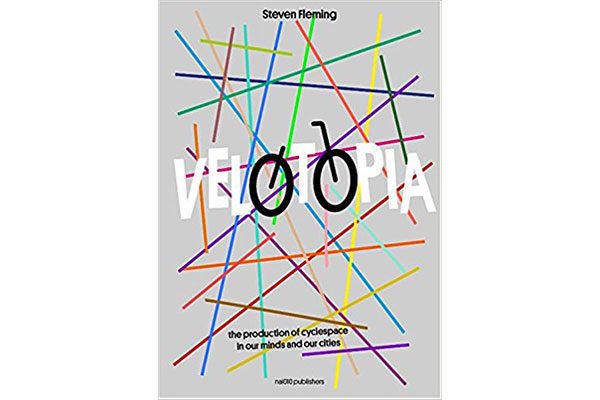
Author: Steven Fleming (nai010 publishers, 2017)
“No one would say Le Corbusier’s Plan Voisin did good for the world, but we can learn so much from his logical process. If Le Corbusier were alive now, grappling with the problems that face us (and if his sponsor wasn’t the car maker Voisin but a bicycle brand), what new vision for cities would he devise?” – Steven Fleming
If bicycle advocates suffer from one major flaw, it’s incrementalism; that is, the willingness of planners, politicians, and policy makers to celebrate meager (and often meaningless) strips of asphalt and paint as victories in the battle to reclaim our cities from the automobile.
In truth, the vast majority of the first world chooses to get around by motor vehicle because it has been made convenient and comfortable by a half-century of car-centric development. And any successful efforts to get large numbers of people out of their cars and onto bikes will require a seismic paradigm shift, away from built environments that are polluting, congested, and obesogenic by design.
Enter Dr. Steven Fleming, an Australian architect, consultant, and author of the 2012 book Cyclespace, who suffers from no such nearsightedness. Fleming argues that not only the fate of our cities rests on shifting from a place for driving to one for cycling, but also – with over 5 billion occupants of developing nations striving to motorize in the coming century – so does the fate of our planet.
Such is the premise of Fleming’s bold new manifesto, Velotopia, which urges planners to think even bigger about the role the humble bicycle can play in the growth of our cities. It rethinks the urban fabric from the ground up, with the cyclist’s speed and scale the primary consideration in the design of buildings, streetscapes, and public spaces. It is as ambitious and uncompromising as Howard’s Garden City, Corbusier’s Radiant City, or Wright’s Broadacre City, only shaped to a human scale.
Fleming envisions Velotopia as a purpose-built bicycling city; not just a place where cyclists are accommodated (the latter of which is true even in urban cycling “utopias” such as Copenhagen and Amsterdam). All aspects of day-to-day life—home, work, retail, and recreation—are readily accessible on two wheels. Apartment dwellers can roll directly up to their front door via a specifically designed hallway and elevator, and then unpack a load of groceries directly into their kitchen, having picked them up in the aisles of the shop on the way home.
At the centre of the book is a protagonist: a hypothetical mother pedalling her child around in a cargo bike. Through her eyes and her priorities, every proposal must be carefully considered and evaluated, particularly her health, safety, money, and time.
Through these four metrics, and a series of real-life case studies in places such as New York, Copenhagen, and Sydney, Fleming summarizes the key ingredients for the Velotopia recipe: a circular city 15 km in diameter, consisting of high-density housing over a permeable ground plane (with most cars and their traffic lights removed, and remaining “essential” vehicles limited to 15 km/hr), and clusters of offices and shops organized around spiralling ramps. Within such a setting, the bicycle becomes the healthiest, safest, cheapest, and fastest way to get around town, and is chosen as the primary means of transportation for 90% of the population.
“In setting the stage for this book, we considered the need for a sustainable model of urban development that the world’s richest 2 billion would choose out of self-interest and in so doing inspire 5 billion more with an alternative to car-centric cities,“ Fleming concludes. While we have seen flashes of this brave thinking in isolation—think Bjarke Ingels’ Danish Pavilion, 8 House, or Malmö’s Bicycle House—these “one off” projects won’t be enough to turn the tide. City builders need to start thinking beyond the curb, at a scale and a scope that allows “… the world’s richest (now driving) and poorest (just walking) to meet in the middle (all cycling).”
***
For more information on Velotopia, visit the nai010 website.
**
Chris Bruntlett is the co-founder of Modacity, a communications and marketing firm focused on inspiring healthier, happier, simpler forms of urban mobility through words, photography, and film.



2 comments
Hi there, Great review! Good te see Velotopia reached Canada already. But the link in this article to nai010 Publishers is wrong.
The best way to visit the nai010website is via http://bit.ly/nai010Velotopia.
Thanks for the correction Anja. We’ve gone ahead and fixed the link!